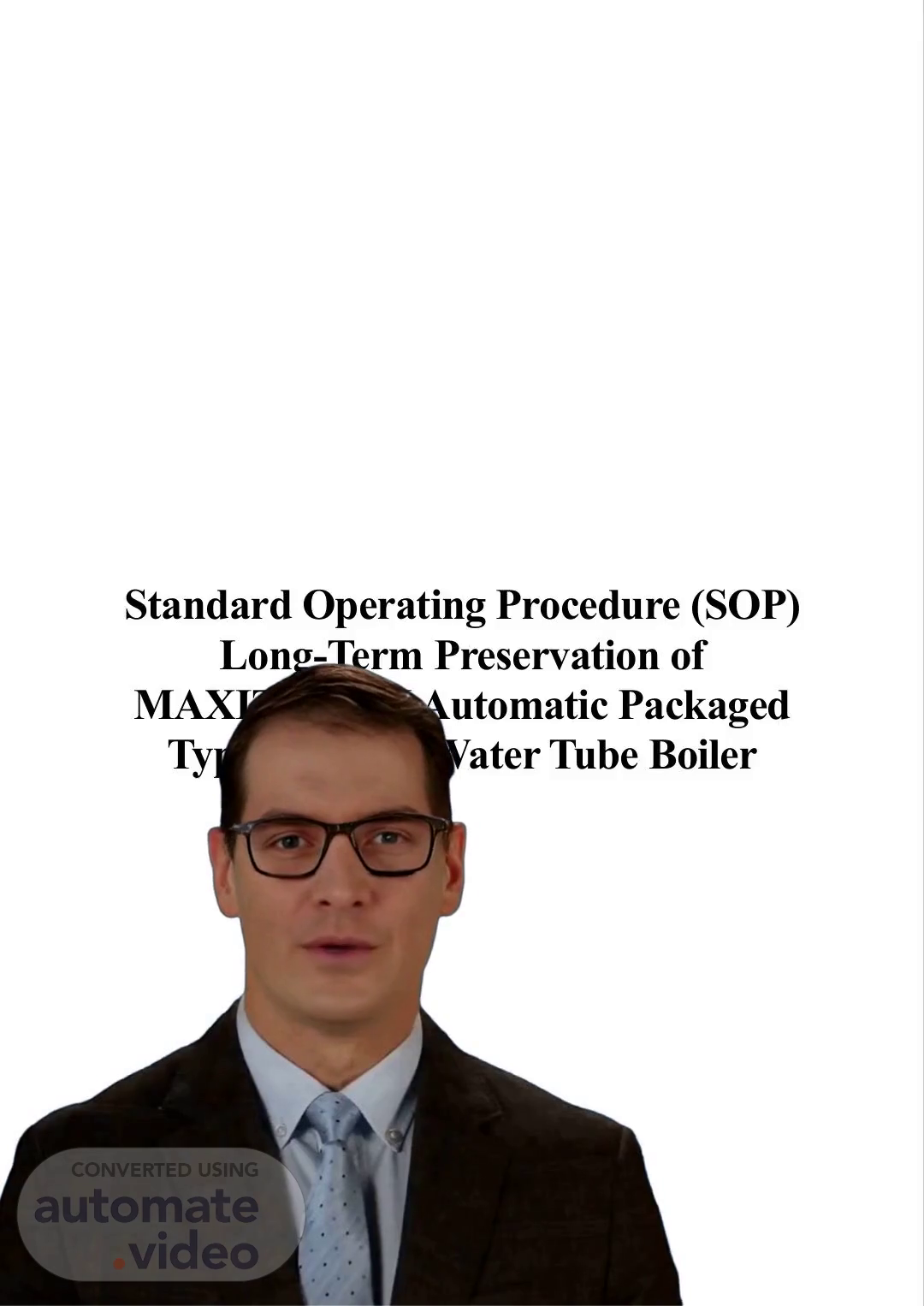Scene 1 (0s)
[Virtual Presenter] The purpose of this presentation is to provide a comprehensive guide on the standard operating procedure for long-term preservation of MAXITHERM automatic packaged type D-shape water tube boilers. We will outline the essential steps to ensure the proper shutdown and preservation of these critical systems..
Scene 3 (24s)
[Audio] The procedure for long-term preservation of the MAXITHERM automatic packaged type D-shape water tube boiler involves several steps. First, notify relevant personnel, including operators, maintenance staff, and other relevant departments, about the planned shutdown. Next, implement lock-out/tag-out procedures on the boiler, fuel system, and associated equipment. Gather all necessary tools and materials, such as silica gel, limestone, descaling agents, drying equipment, and protective covers. Then, gradually reduce the boiler's load to bring it to a safe operational state. Turn off the fuel supply, shut off the air supply to the burner system, close the feedwater valve, and stop the feedwater pump. Safely vent pressure from the boiler. Perform a complete blowdown by opening the blowdown valve to remove sludge, scale, and contaminants. Finally, de-energize the boiler, drain the water from the boiler, and inspect and clean the boiler. Apply preservation chemicals, such as silica gel for moisture control and limestone for corrosion protection, according to practical guidelines..
Scene 4 (1m 43s)
[Audio] This Standard Operating Procedure outlines the steps for the long-term shutdown of a MAXITHERM Automatic Packaged Type D-Shape Water Tube Boiler using the dry method with chemical preservation. The procedure covers the application of silica gel in the water side and limestone in the fire side to prevent corrosion and degradation during the shutdown period. Boiler Operators will implement the shutdown procedure, including draining, cleaning, and applying the chemical preservation methods. The Maintenance Team will ensure correct application of preservation chemicals and perform necessary inspections. Safety Personnel will ensure compliance with lock-out/tag-out procedures and other safety protocols. Supervisors/Managers will approve the procedure and ensure completion of all documentation. The required tools and materials include lock-out/tag-out devices, blowdown valve and pump, cleaning tools, silica gel, limestone, protective covers and seals, descaling agents, inspection tools, and drying equipment..
Scene 5 (2m 47s)
[Audio] Before preparing the boiler for shutdown, it's crucial to notify relevant personnel, implement lock-out/tag-out procedures, and gather all necessary tools and materials. This preparation step ensures a safe and controlled environment for the shutdown process, thereby minimizing the risk of accidents and guaranteeing the boiler is properly prepared for shutdown..
Scene 6 (3m 10s)
[Audio] The boiler preservation process requires inspecting and cleaning the boiler. A detailed examination of both internal and external components is performed to detect any signs of wear, corrosion, or damage. Affected areas are then cleaned using specialized equipment like brushes and pressure washers. Descaling agents might also be used to remove any hard deposits that have accumulated inside the boiler..
Scene 7 (3m 35s)
[Audio] Silica gel should be distributed evenly throughout the boiler, particularly near areas prone to moisture accumulation such as the drum, headers, and other key locations. Mesh bags or trays should be used to allow air circulation and prevent silica from spilling out. Ensure that the bags are perforated to allow moisture absorption. Regular inspections should be conducted every 4-6 weeks to check for saturation. If using indicator silica gel, regeneration is possible through heating in anoven. Alternatively, replace the silica gel with fresh material if it cannot be regenerated or is too heavily saturated. Safety precautions include wearing gloves, using a dust mask, and disposing of silica gel according to local regulations..
Scene 8 (4m 21s)
[Audio] Limestone calculation for fire side preservation requires us to determine the amount of limestone needed. The industry rule suggests that one kilogram of limestone is sufficient for every ten cubic meters of volume. In this case, we have two volumes: the combustion chamber volume, which measures 20.73 cubic meters, and the volume from the burner to the flue, which measures 33.52 cubic meters. To find the total fire side volume, we add these two values together, resulting in a total volume of 54.25 cubic meters. Based on the industry rule, we would require 5.42 kilograms of limestone. However, to be safe, we apply a safety factor of 1.5, which gives us a final requirement of approximately 8.07 kilograms of limestone..
Scene 9 (5m 14s)
[Audio] Secure the boiler by closing all valves, vents, and drain ports. Next, use protective covers to seal manholes, inspection ports, and other openings to prevent the entry of moisture or contaminants. If necessary, utilize air blowers or dehumidifiers to dry the boiler before sealing. Following this, document all actions taken, including chemical usage, and inform management and maintenance that the boiler has been successfully shut down and preserved. Moreover, guarantee that the surrounding area is well-ventilated throughout the shutdown..
Scene 10 (5m 53s)
[Audio] The references used in this procedure are the MAXITHERM Boiler Manufacturer's manual, plant standard operating procedures, and guidelines from the Occupational Safety and Health Administration for boiler safety and chemical handling. These resources provide essential information for ensuring the safe and effective preservation of the MAXITHERM automatic packaged type D-shape water tube boiler..
